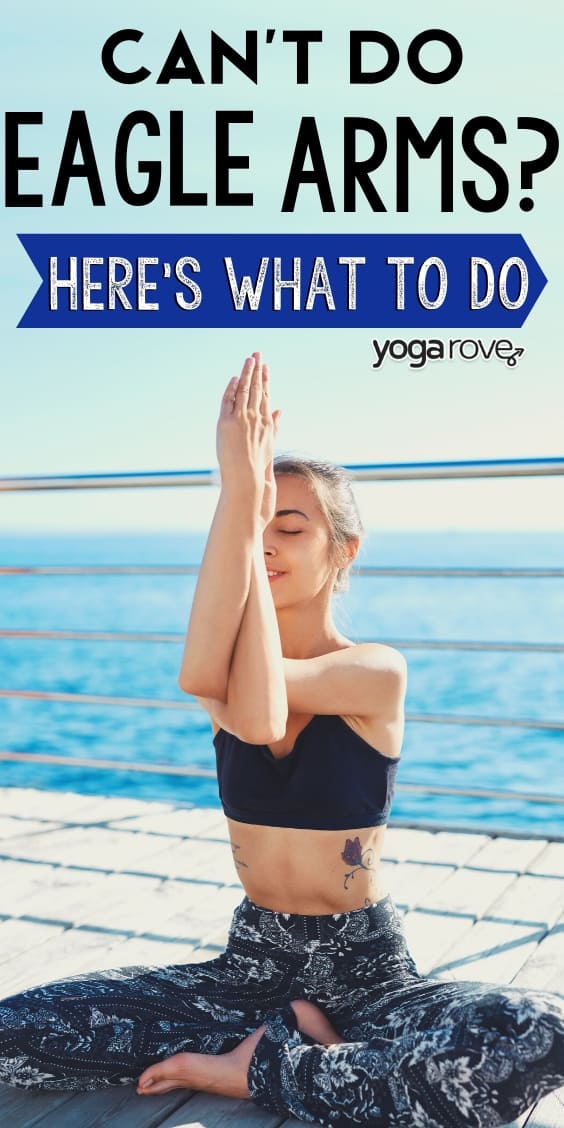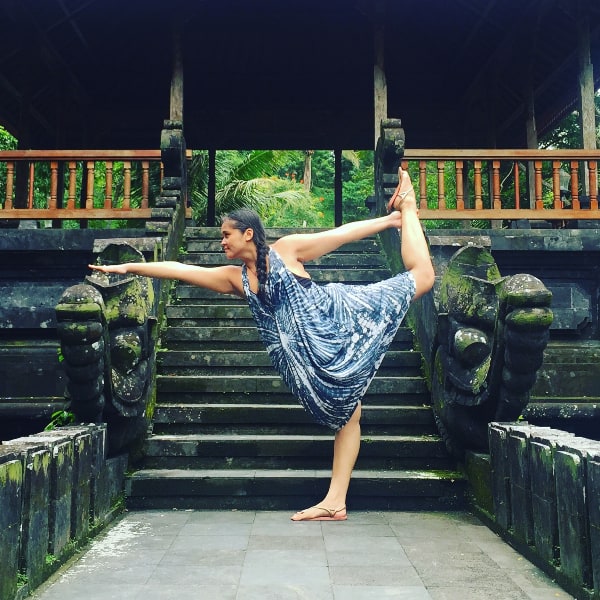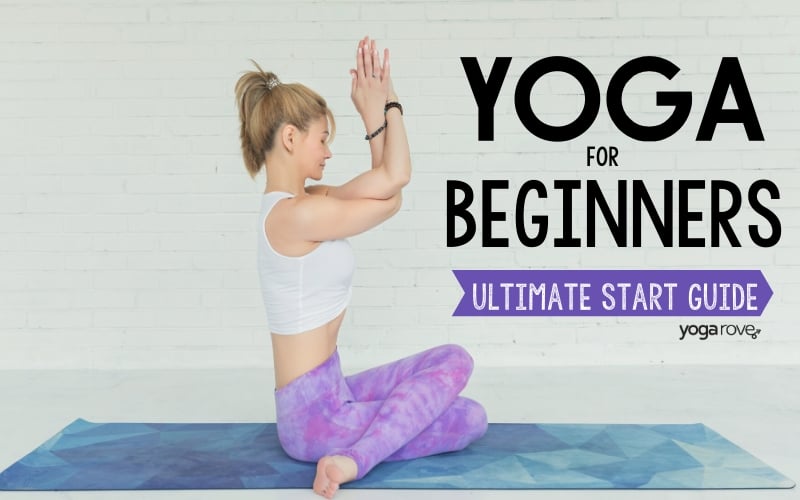This post may contain affiliate links. Please read our disclosure for more info.
You are all too familiar of that part in class when your yoga teacher says, “Right arm under left arm, cross the arms, and interlace your fingers or press your palms together in a prayer. Find your eagle arms.” But what if you can’t find your eagle pose arms?

What if your arms just won’t cross they way that your teacher so seamlessly crosses them? And interlaced fingers? Forget about it! There are many yogis who make the full expression of eagle arms look easy, but know that there are many modifications that can help you to practice your safest and more comfortable version of eagle arms.
Can’t do eagle pose arms? Here is what to do. Many people have trouble with eagle arms because of tight shoulders or back muscles. To increase flexibility and openness, practice eagle arm variations and modify your eagle arms to slowly build up to the full expression.
The full eagle pose, or Garudasana in Sanskrit, consists of wrapping both the arms and legs around, intertwining them like rope. However, in a yoga, there are many other poses in which you can practice eagle arms as a variation, so you may find yourself practicing eagle arms in many different poses during your practice.
For some practitioners, eagle arms comes relatively easy for them, while for others, it takes some time to build up the openness and flexibility in the body to find the full expression.
Modifications for Eagle Pose Arms
If you feel discouraged by the fact that you are not able to interlace your fingers or press your palms together, know that by practicing modified variations, you can still receive the benefits of the pose and increase your flexibility.
Yoga is not about the destination. Rather it is about your journey through your practice and finding openness and acceptance in your body and the moment. Modifying your eagle arms allows you to still practice the pose, while opening your body to increase flexibility. And who knows? With solid practice, maybe one day you will be able to fully wrap your arms around and interlace your fingers!
There are many variations that you can safely practice for your eagle arms. Some great modifications are:
- Eagle arms with a strap: For some yogis, it can be challenging to cross the arms at your chest. Straps are wonderful props to use in yoga and can be used to modify eagle arms. Holding the strap with one hand, cross your arms and clasp the strap with your other hand, You can control how much of a stretch you want with the tightness of the strap.
- Give yourself a big hug: If it’s tough to cross your arms, give yourself a big hug and work on reaching for the opposite shoulders. Place your hands as far around the shoulders as you can— the tighter you hug, the more of a stretch you will feel.
- Grabbing a wrist: If you are able to cross your arms and are very close to interlacing your fingers or pressing your palms together, use your opposite hand to clasp onto the wrist of the arm that is on top. Little by little, you can start to inch your hands closer to each other, and eventually interlace your fingers or press your palms together in a prayer.
- Prayer hands: If you would prefer to cross your arms at all, you can modify by placing your hands in a prayer position and bringing your elbows in to touch. Work on rolling your shoulders back, keeping a straight spine, and broadening through your collar.
What Makes Eagle Arms so Difficult?
Eagle arms consist of crossing the arms twice at the elbows and the wrists and eventually interlacing your fingers or pressing your palms together. Practicing eagle arms opens up the upper back, deltoids, and shoulders and can be very intense, and even difficult for some yogis. While some practitioners can easily get into the full expression of eagle arms, there are many, many yogis who find every aspect of the pose challenging.
You may find that eagle arms is more difficult of you if you have:
- A larger chest
- Tight shoulders, upper back, or deltoids
- A shoulder or deltoid injury
Be sure to practice mindfully and carefully, and try out eagle arm modifications to slowly build up your strength and flexibility. Remember that modifying a pose does not mean that you are not practicing the posture— in fact, you are practicing eagle pose arms exactly the way that your body likes it, and you are still getting all the benefits by modifying.
Warm Ups for Eagle Pose Arms
Before practicing eagle pose arms, it can be beneficial to warm up your entire body, specifically the shoulders, deltoids, and the upper back. There are many stretches that you can do before your yoga practice or within your yoga practice before you practice a pose with eagle arms.
- Deltoid stretch: Everyone knows this classic stretch from gym class at school. Reach one arm across your body at chest height and use your opposite elbow to support your arm. To deepen the stretch, use your opposite arm to pull the straight arm closer to your chest. Hold for five deep breaths on each side.
- Interlaced fingers: Sitting in an easy pose, reach behind your back and interlace your fingers. Press your palms together and keep a slight bend in your elbows to avoid hyperextension. Roll your shoulders up, back and down, and slowly begin to move your hands away from your body. If it is challenging to interlace your fingers, use a strap instead of the interlace. Hold for five deep breaths or longer.
- Child’s pose: Allow your shoulders and upper back to relax with this posture. Open your knees out mat-width distance and bring your big toes to touch. Walk your hands forward and rest your forehead on the mat. Make sure to soften your shoulders away from your ears to release any tension in the shoulders, upper back, and your neck.
Practicing the Full Eagle Pose
Eagle pose arms are most commonly practiced during eagle pose. The full pose consists of not only wrapping your arms but your legs as well— all while balancing on one leg! The pose is quite challenging and holds numerous benefits including:
- Increased balance and concentration
- Opens up all the major joints in the body
- Opens up the shoulders and the upper back
- Strengthens the knees, ankles, calves and thighs
To come into full Eagle Pose:
- Bring your feet together and your big toes to touch. Bend your knees and reach the arms up overhead into a chair pose.
- In chair pose, swing your right arm underneath your left arm. Cross the arms and interlace your fingers or press your palms together. If you are modifying your eagle arms, take the modified variation of your choice.
- Shift your weight to your left leg. Lift your right leg up and over and cross your legs. You can stay here, or begin to wrap your foot around your calf muscle. Eventually, you can hook your toes around your ankle.
- Sit low and keep your weight to your left heel. Squeeze everything towards the midline of your body.
- Lift your chest up, lift your elbows up, and relax your shoulders away from your ears.
- Find one spot to focus on and soften your gaze. Stay for five breaths.
- Practice the opposite side right after.
Which Yoga Poses Have Eagle Pose Arms?
You may find that you are practicing eagle pose arms in other poses other than eagle pose. Many teachers like to add an eagle pose arm variation to different yoga postures during practice, so don’t be surprised if you find yourself in Warrior 3 with eagle arms. Sometimes, eagle arms may be a theme in class and could show up in a few different postures during your yoga class.
Some poses that can be practiced with eagle arms include:
- Humble warrior
- Gomukasana or Cow Facing pose
- Goddess squat
- Warrior 3
- High lunge
- Warrior 1 and Warrior 2
If you are practicing any of these poses in class or during your home yoga practice, remember to take the variation of eagle arms that best serves you. Modify your eagle arms so that it is comfortable in the pose and in your body. Finding the best variation of eagle arms that works for you not only honors your body and practice, but also helps to build openness and flexibility where you may need it.
Related Questions
How do I modify full eagle pose? If it is challenging to balance in full eagle pose, cross your legs, but place your toes on the mat or the block. This will help you to build strength, concentration, and balance, and eventually lift your toes off the floor.
Should I bring my elbows close to my body or away from my body in eagle arms? There are different ways to practice eagle arms and both variations are used in a yoga practice. Your teacher may choose to practice it a certain way depending on her sequencing for class.







So I’m using eagle pose in my class tomorrow and I’m just refreshing my memory on variations of eagle arms. I look on Pinterest at an article and begin reading! Absolutely perfect variations then I scroll down to see your name on the article! My teacher so funny! Miss you
Great tips! I’ll keep these in mind when practicing Eagle Pose. Thanks for sharing!